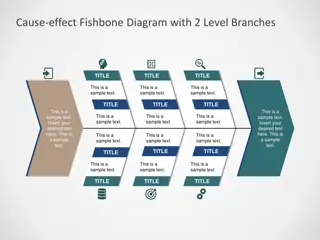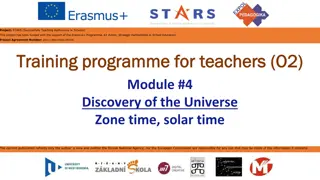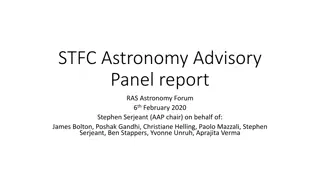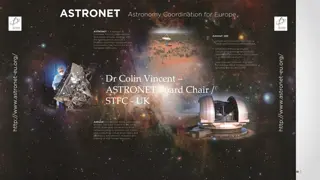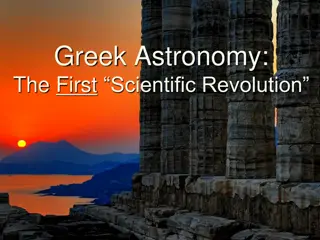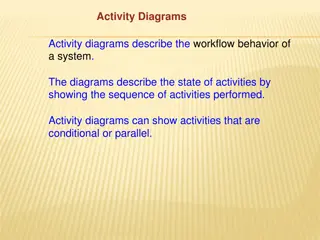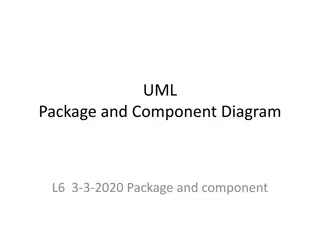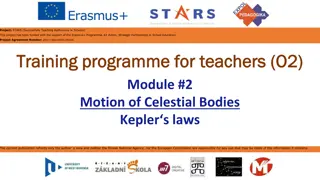Understanding HR Diagrams in Astronomy
HR diagrams, named after astronomers Hertzsprung and Russell, depict stars' properties and relationships. The main sequence in the diagram shows where stars lie while fusing hydrogen to helium in their core. Learn about different types of stars and their positions on the diagram. Explore the significance of the main sequence and how it correlates with stars' mass and lifespan.
Download Presentation

Please find below an Image/Link to download the presentation.
The content on the website is provided AS IS for your information and personal use only. It may not be sold, licensed, or shared on other websites without obtaining consent from the author. Download presentation by click this link. If you encounter any issues during the download, it is possible that the publisher has removed the file from their server.
E N D
Presentation Transcript
HR Diagrams Written by David Ilsley
HR stands for: A. B. C. D. E. F. G. Hip Replacement H. Hertzsprung-Russell Human Resources Horse Race Heart Rate Chuck Norris Hairy Rat Home Renovation Image: pxfuel.com
In astronomy, HR generally stands for Hertzsprung-Russell, as in a Hertzsprung-Russell diagram. This is a diagram that shows the properties of different types of stars and the relationships between them. Image: flickr.com
HR diagrams are named after two astronomers, Ejnar Hertzsprung and Henry Norris Russell, who developed the idea independently in 1911 and 1913. They consist of a plot of stars on a scatter graph of brightness vs surface temperature. The next slide is another HR diagram with different information. Image: commons.wikimedia.org
The Main Sequence The main sequence is the light purple band running across the diagram. This is where all stars lie when they are fusing hydrogen to helium in their core. It is where they spend most of their lives, from trillions of years at the bottom right end, to about 10 billion years where the Sun is, to about a million years at the top left end.
The name main sequence makes it sound a bit like stars move along the line as time goes by. But they don t. Stars stay pretty much in the same spot on the line throughout their main sequence life, just moving slightly upwards as helium builds up in the core and the core temperature increases. A star s position on the line is determined by its mass. Low-mass stars sit towards the bottom-right end of the line and are red dwarfs like Proxima Centauri. More massive stars sit further up and left and are yellow dwarfs like the Sun, blue-white stars like Sirius or blue giants like Spica. The M=10 label on the diagram means that main sequence stars at that point on the diagram have a mass 10 times that of the Sun. Similarly for the other M= labels.
When we talk about a main sequence star, we mean a star which is going through its main sequence life, i.e. is burning hydrogen in its core and so is sitting on the main sequence line.
The green diagonal dotted lines on the diagram show the radius of stars compared to the radius of the Sun. You will notice that main sequence stars from M=0.5 to M=10 all have about the same radius. This is because more massive stars have more gravity and so suck themselves in more, making up for the extra bulk. Red dwarfs are smaller and blue giants are bigger, though.
Off the Main Sequence Although stars spend most of their lives pretty much in one spot on the main sequence, the beginnings and ends of their lives are characterised by major movements around the HR diagram. The HR diagram is an excellent tool for showing these changes.
Before their Main Sequence Lives Stars condense from clouds of gas and dust. They heat up and start to glow when they are still quite large. They then get smaller and hotter until they are hot and dense enough to begin fusion and they take their place on the main sequence.
They come in from the right side of the diagram, then settle on the main sequence line. The sun took about 50 million years to go through this process. The largest stars do it in about 50 thousand years or less; the smallest can take hundreds of millions of years.
After their Main Sequence Lives The lives of stars after the hydrogen in their core runs out and they leave the main sequence are much more interesting. They include the production of red giants, supergiants, planetary nebulae, white dwarfs, black dwarfs, supernovas, neutron stars and black holes. We will look at the post-main-sequence lives of red dwarfs first, then progress to higher-mass stars.
Red Dwarfs Red dwarfs have a mass between 0.08 and 0.5 solar masses. Anything smaller that condenses from a gas and dust cloud is a brown dwarf (0.013 to 0.08 solar masses) or a gas planet (less than 0.013 solar masses). Brown dwarfs and gas planets don t get hot enough to fuse hydrogen, so aren t classified as stars and don t make it onto the main sequence. They would generally lie off the bottom right of the HR diagram.
Because they burn their hydrogen so slowly, red dwarfs spend many billions or even trillions of years on the main sequence before it runs out. No red dwarf in the universe has yet run out of hydrogen, but we have a good idea what will happen when they do.
When their hydrogen is nearly gone, they collapse a bit, then heat up and shine a bit brighter for a while, before cooling down again and eventually turning to a black dwarf billions of years later. Their post-main-sequence paths are shown on the diagram below.
Sun-like Stars Stars from 0.5 to 8 solar masses follow a different path. They become red giants, then throw off planetary nebulae before shrinking down to a white dwarf. The path the Sun will follow is fairly typical and is shown below.
We will now look at what is happening in each leg of this journey.
When the Suns core runs out of hydrogen, fusion stops and, being unable to provide enough heat and radiation pressure, the star collapses somewhat. This causes the temperature to rise sufficiently for hydrogen in a shell around the core to begin to fuse. This in turn causes the outer layers of the star to heat up and expand. The star moves upwards on the HR diagram and becomes a red giant, expanding to approximately the orbit of Venus. More heat is produced, but, as it is radiated from a much larger surface, the surface becomes cooler. This expansion continues for about one billion years.
During this billion years, the star becomes gradually hotter inside. Eventually, the core gets to about 100 000 000 K, hot enough for helium to fuse to carbon and oxygen. The necessary conditions are reached first at the centre of the core. Once the fusion of helium begins, it provides a lot more heat, which causes the next layer of helium to fuse and so on. The whole core is converted to carbon and oxygen in just a few minutes. During those few minutes, the Sun will produce as much energy as the entire Milky way does in the same time. This event is called the helium flash . However, the energy produced is not quickly transmitted to the surface, so an outside observer doesn t see anything.
The helium flash causes the core to expand and this lowers the temperature and slows down the fusion of hydrogen in the shell. The star contracts again, though it remains bigger than it was as a main sequence star. This part of the path across the HR diagram is called the horizontal branch . The star spends about 100 million years on this branch.
The star heats up again until it starts to fuse helium in a shell surrounding the carbon-oxygen core. This causes another expansion, this time to about the orbit of Earth. This part of the path across the HR diagram is called the asymptotic giant branch . The star spends only about a million years on this branch.
During the asymptotic giant phase, the star changes size and brightness with a period of a few thousand years, ejecting some of its outer layer with each pulsation. It then undergoes a fairly rapid sequence of larger explosions which rid it of all but its core, producing a planetary nebula. Image: pixabay.com Image: picryl.com Image: stockvault.net Image: pixabay.com
The remaining core is extremely hot and small. The star therefore moves very rapidly to the left side of the HR diagram and beyond. No further fusion takes place, so the star cools, quickly at first, bringing it down to the white-dwarf area of the diagram, and then slowly, taking it, over billions of years, off the bottom right of the diagram to become a black dwarf.
Heavy Stars Stars of more than 8 solar masses follow yet a different path. After fusing hydrogen to helium, then carbon and oxygen, they fuse carbon and oxygen to heavier nuclei like magnesium, silicon and iron. Then they explode as a supernova, leaving a neutron star if they are less than about 20 solar masses or a black hole if more than 20 solar masses. On the HR diagram, they leave the main sequence once the hydrogen in the core is used up. They then expand and head horizontally to the right, progressing faster and faster as each new element is used up more quickly. In just a few thousand years, they develop an iron core and explode as a supernova.
The remaining neutron star or black hole goes almost immediately off the left side and/or bottom of the HR diagram.










